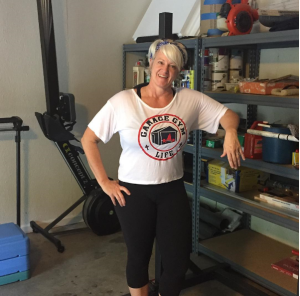John Greaves III's Blog, page 9
August 8, 2017
Recovery By Rich Dlin
Recovery can mean so many things. For gym rats, it’s what we do after a workout. A time when the damage we did with the weights heals, muscles adapting to this latest stress we’ve put to them, so that next time … next time they will be ready. They get stronger. They get more efficient. The heart is a muscle. And, philosophically speaking, so is the mind.
Growing up, I was a skinny kid. When I hit puberty, I started to gain fat slowly, but steadily. As an adult, I floated on a wave of gaining and losing, reaching a peak of 250 lbs. In my 30’s I started lifting weights regularly, eventually setting up my own gym in the basement of my house. I also began paying much more attention to nutrition, but as a confirmed food addict, I always struggled with proper diet. Then, in 2014, I had a heart attack.
losing, reaching a peak of 250 lbs. In my 30’s I started lifting weights regularly, eventually setting up my own gym in the basement of my house. I also began paying much more attention to nutrition, but as a confirmed food addict, I always struggled with proper diet. Then, in 2014, I had a heart attack.
45 and Almost Dead
That’s right. At the age of 45, I had a heart attack. In the photo from 2011, I weighed about 250 lbs. I don’t want you to be misled in any way. I was not at that weight when it happened. Thanks to a good run of discipline in the kitchen and gym, I weighed about 225 lbs., much of which was muscle, but certainly on the fat side. You can read about the heart attack itself (and many other topics, for that matter) on my website. I won’t go into details here except to say it was damn scary. I naturally assumed it was due to my weight and/or my eating habits. In fact, the cardiologist told me that it was neither – just genetics. Since I don’t drink or smoke, and since I was not really in bad shape physically, he told me I had “no correctable risk factors”. That was scary to hear. But he also told me that now that we knew that I am prone to this, and now that I was the proud owner of 3 brand new stents, we can control it with medication. He assured me that I can lead a normal, healthy life.
Normal. Healthy.
Those are two heavy words. The first one offends me a little. Who wants to be normal anyway? But the second one means so much. That heart attack was scary. I remember a friend of mine is a doctor who does rounds at the hospital where I was staying stopped in to chat the next day. He told me guys my age that have a heart attack can go on to lead healthy lives, seemingly unaffected. I remember asking him about weightlifting, which I had already sacrificed it in my mind. How could anyone who had a heart attack keep on lifting heavy weights? Prior to my heart attack I had been putting up some big numbers. I deadlifted 405 lbs. for 4 reps, benched a 315 lb. single, benched 225 lbs. for 20 reps, and I managed 20 pull-ups in one set. I had goals – a 495 lb. deadlift, 315 lb. bench for 4, 225 lb. bench for 30, and 40 pull-ups. The heart attack made me say goodbye to all of them, both because I didn’t see how I could do that anymore, and because I wasn’t sure I should even try. My friend said of course I could still lift. I said I lift really heavy weight. He said, so what?
Wow. You mean I can still lift? It was hard to believe. My cardiologist said sure, when you’ve recovered from the heart attack and the angioplasty, why not? He also said I need to make sure to do cardio to exercise my heart and help it recover from the damage.
Four Elements of My Recovery
See? There’s that word: Recovery. My heart was damaged. So, I had to set out to make it stronger. I had to make it more efficient. Recover is what I set out to do. I consider as a way of being: It’s not a destination, it’s a journey. I break it into four distinct but very related categories: Cardio, Weights, Diet and Therapy.
Cardio
 The Diamondback
The DiamondbackAs soon as I got the go-ahead from the doc to start pushing my heart rate, I did. The doc said I should make sure to do cardio so that my heart rate was elevated to roughly 80% of max for 45 minutes, 5 times/week. It has been about three years since I got that instruction, and in that time, I have honestly missed about 5-6 sessions, in total. At one point my streak was over 104 weeks straight. 45 minutes on my elliptical, plus a 4-minute cooldown. I try to keep my heart rate in the 140’s for as much of the session as possible, though some days it doesn’t want to go there, whereas others I feel like I have the wind at my back and it gets up into the 150’s or even short spans in the low 160’s. I’ve asked my doctor if those higher numbers are safe, and he said if it doesn’t hurt, and if I can speak in full sentences, then I am fine. Guidelines are just guidelines. I had a Diamondback elliptical that I used to use from time-to-time before the heart attack, but it broke soon after with the regular use. I wanted to replace it with something sturdier, and I never buy exercise equipment new unless I absolutely must. During the time it took me to find a replacement I would get temporary free introductory passes to local gyms, and when those ran out I actually did cardio in my leg press, with one 45 lb. plate on each side, doing reps for 45 minutes, resting only when I had to and only for as long as it took for me to get my legs going again. Eventually I found a great deal on a used Octane elliptical. It’s a tank! Takes a pounding from me 5 days week and never complains. It wasn’t cheap – but it was worth it. I also sprang for a TV which I mounted on a shelf right at eye level. The TV, coupled with an Apple TV, serves as the entertainment hub for my basement gym. Netflix gets me through my cardio!
Weights
 2017
2017I also started lifting as soon as I got the go-ahead. At first, I was scared. I went back to square one – benching and squatting the bar only, curling the 10’s … I wasn’t trying to get big or strong, just trying to reacclimate my body – and honestly my mind – to the iron. I imagined it would take months to feel like my old self again under a bar. I was super-cautious, recording my blood pressure before and after sets, making sure it didn’t spike too much. It was not an over-reaction. I believe to this day that all that caution and trepidation was necessary. I had to re-learn the art of listening to my body. All of it. The joints, the muscles, and of course, my heart, (right, I know – that’s a muscle too – but let’s admit it’s a special one worthy of listing separately, okay?) all needed my attention.
Adjusting Priorities
I made quick progress, although it took me a long time to start to believe that my old numbers might make themselves known again. My deadlift is probably not going to make a reappearance, but not because of my heart. I have accumulated too many back injuries over the years, due in part to undiagnosed scoliosis and in part to the ego of my inexperience early on. When I deadlift now, I keep it to 225 lbs., tops. But my bench is getting strong again. I can bench 275 lbs. for a single, and at my last chest workout I managed 225 lbs. for 15 reps. I have managed 20 pull-ups in one set again. My goal now is 50 for my fiftieth birthday. When I train I keep the intensity high for each rep. I think of every rep as a complete workout, every set an accumulation of victories, and every workout a war, won in the battlefield of my little basement gym. I don’t plan to compete in any contests ever again – the taste for that is just not there. And I don’t have any goals but to make myself better each workout. I don’t compare myself to others, but I love to see other gym warriors at all levels. The ones who have pushed farther – who might be viewed as somehow “better” if I were using a different lens – don’t make me get down on myself. They inspire me about what is possible.
Diet
Diet is actually a dumb word, thanks to the fact that it is most commonly used as a verb, or like a proper noun. I am dieting. I am on a Diet. I don’t blame anyone for that, but it does make me reticent to use the word to express the concept. To me, diet refers to the nutrition you consume. As in, my diet is comprised mostly of whole foods. Which is true. But there’s more to it.
Before my heart attack, food was always an issue for me. I was always – I mean always – fighting the urge to eat more, or eat the wrong thing. I am a food addict. Eating was always a negotiation for me. Even before I really knew about proper nutrition, I still knew you’re not supposed to eat 4 Wunderbars back-to-back. So, whenever I did, it was always a negotiation. And as any chronic overeater will tell you, you always negotiate a future consideration. As in well, I can eat this ice cream now, and then tomorrow I will go for a walk and only eat salad. It is also true that for many, tomorrow never comes. But mine did. Wrapped up as a heart attack.
Ever since the heart attack there has been no negotiation. I do not want to add any risk to whatever I already have, thanks to genetics. I have simple rules:
My Rules for Living
Choose whole foods whenever possible
minimize cholesterol and fat (steer as far away from saturated fat as possible)
make sure to eat enough protein to support muscle growth, and never overeat.
I don’t measure anything, although from years of having done so I admittedly have a sense for what the food scale would say. Truth is though, the never overeat rule takes care of the measuring. My body tells me what it needs, and how much – I just have to listen.
After my heart attack and once I started exercising, I would weigh myself regularly, and often. I went from 225 lbs. to 185 lbs. But I found I cared less and less about what the scale was telling me. Listening to my body is much more meaningful than reading the scale. Slowly, my frequency of checking the scale went down. Not as a conscious plan, but because I just didn’t think to do it. Now, for fun, I check once every 3-4 months. I did gain weight from the 185 lbs., due to the time in the gym, but I am still wearing the same size pants. For those that are interested, I currently weigh 200 lbs., and have been at this weight for almost 2 years. Truthfully, I don’t care. I feel great. My clothes feel great. My kids and my wife love me, and I love them.
Therapy
Anyone who has gone through something like a heart attack will tell you how it changes your perspective on mortality. For me, it has certainly brought anxiety. Any twinge I feel in my chest makes me wonder. And the wondering makes me anxious. And the anxiety makes my chest hurt. The circle is as terrible as it is obvious. I needed a way to calm the anxiety, and surprisingly the gym doesn’t do it. Probably because if I were having another heart attack, working out would exacerbate the pain, so my brain doesn’t allow that to be the outlet it is for so many other types of stress. I found I needed an activity to get lost in. About two years ago I set out to learn to draw. My goal was to leverage my passion for bodybuilding and draw muscled up characters. At first, I sucked at it. But when I was drawing I realized the phantom chest pain disappeared entirely. And the more I drew, the more it stayed away. In other words, I could control the anxiety by drawing! So I drew, and drew, and drew some more. I am very fortunate that my career as a high school teacher allows me to have the summer months off. That first summer I probably spent 8-10 hours a day, seven days a week; drawing. I made progress and the progress spurred me on, just like in the gym.

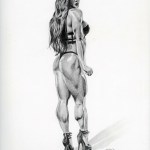
Most weeks I draw at least three days. Some weeks every day. I can draw for 30 minutes or 5 hours. It all depends on how my day is shaping up and how I feel. Of course, the anxiety still surfaces sometimes. It always will. But I know that when I draw, it leaves, and that gets me through it with a smile.
Want to read more from Rich? Or keep up with his progress?
Follow him on Instagram @richdhomegym
See more of Rich’s art @studiodlin on Instagram.
Commission Rich to do a piece by contacting him at https://www.studiodlin.com/
The post Recovery By Rich Dlin appeared first on Garage Gym Life.
Embrace the Lifestyle
 The Lifestyle
The LifestyleI embrace the lifestyle. Started two years ago on the garagegym setup. Buy, sell, create the way is all part of the process. The fun never stops.
Nothing is Off Limits
What I love about it most: the freedom. I can train when I want; how I want. It also forces me to be creative and get out out of my comfort zone. Nothing is off limits.
Embrace the Lifestyle
Heat or cold only make me tougher. I could never go back to a commercial gym.
Follow Kyle on Instagram @kknoll4
The post Embrace the Lifestyle appeared first on Garage Gym Life.
August 1, 2017
Val Airing is Seeking Her Full Potential by Helping Others
Val Airing is on fire and motivated to reach her full potential by helping others! When I saw her YouTube channel and Instagram profile, I knew right away that this is someone who deserves to have their story told! Get to know this fitness enthusiast right now!
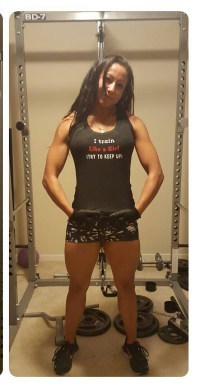 Val, how long have you been exercising?
Val, how long have you been exercising?Off and on four and a half years. Health and fitness has always been a part of my life. After reaching my heaviest weight for my height, I realized that is not where I wanted to remain. I decided to make a lifestyle change and found a new love for fitness. After I succeeded in reaching my weight loss goal. I then proceeded further into my fat loss journey. Since then I only have wanted to continue my journey to seek out my full potential in training.
I know that you said that your journey took a lot of trial and error in and out of gyms. Did you begin your fitness journey in a home gym?
I did not begin my journey in a home gym. Fitness 19 was the gym where I started my journey. The reason behind leaving the gym was due to relocation and convenience. I don’t necessarily have anything against a gym facility. I train just about anywhere.
You originally started training to lose weight. What have been your most powerful weapons to transform your body?
Exercise and clean eating habits. It took some patience through many trial and errors in and out of gyms, but I pushed my way through and lost the weight.
People often think of fitness as a destination rather than a journey. I think those people are the ones who tend to lose weight and gain it back as opposed to people who are constantly looking for the next way to challenge their body. What are your personal fitness goals now that you’ve lost the bodyfat?
To share my knowledge. Compete one day in a bikini and/or figure competition. Through my journey I experienced many ups and downs emotionally, physically, and mentally. I remember what it felt like to struggle in simple activities with my heaviest weight. As well as the many times I wanted to quit and give up. Since I managed to surpass those deterring thoughts, I had felt I could resonate with others in similar journeys. I now pursue a passion of helping others on their fitness expeditions. In hopes of motivating them to discover their strength and confidence to succeed as well.
You mentioned wanting to do a competition one day. Do you compete or play a sport now?
I trained Brazilian Jiu-jitsu off and on for about four and a half years and competed a few times.
A lot of people would be surprised at how effective many grappling drills are great for condutiobing. Do you use your Jiu-jitsu background when programming for clients?
No I do not. Just what my coach taught me. “An angry mind is a narrow mind.”
Let’s talk about your gym and the equipment you have. What did you start your home gym with?
5lb dumbbells and bands.
What was the first thing you added to the gym?
A squat rack with weights and bench.
What do you plan to purchase next?
The goal is to go for a leg press.
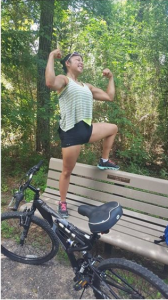 Do you take on in person clients as part of your fitness business or do you do online training?
Do you take on in person clients as part of your fitness business or do you do online training?I travel to clients in the comfort of their own home and or at parks in person. Online training is another goal in the process.
What is the hardest part about being a home based fitness professional?
The space, coverage and weather.
That’s something I’ve heard from other home based fitness professionals. You’re at the mercy of the weather especially. How do you adapt if say, the weather’s bad? Do you cancel and do it a different day or do you have a backup location you use?
If the weather is not too bad I use the pavilions. Otherwise if it’s lightning and thundering, I will reschedule the outside session.
How would you describe your training style for yourself and how does it compare to how you train others?
I train with a mixture of weight training and cardio. Whereas my clients’ goals vary from strength to weight loss to fat loss.
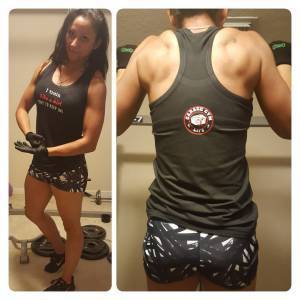 What advice do you have for someone planning on starting their first home gym?
What advice do you have for someone planning on starting their first home gym?Do not give up. If you want to be a trainer, be ready to consult with other business professionals to cover all aspects of the industry.
Thanks for sharing your story with us Val, and thank you for your support of Garage Gym Life! Where can people connect with you to hire you for your services or just follow your fitness journey?
Business contacts: Email- fetlifemvp@gmail.com
Instagram- @fitnessenthusiastjp
Facebook- Fitness Enthusiastic Training or Alluring Val Airing
Youtube- Fitness Enthusiastic Training
The post Val Airing is Seeking Her Full Potential by Helping Others appeared first on Garage Gym Life.
July 25, 2017
Garage Gym Showcase: Al’s House of Shred
Al’s House of Shred, a basement gym in upstate New York run by former powerlifter, Alberto @boricuabarbell Velasquez and his wife Danni. We talked about the pros of group training in your garage and this is the perfect example! I’m so grateful to Al because he was the first garage barbell club owner to share the story of how he makes it work. Every week Al opens up his home to trusted friends every week as part of his personal mission to pass on what he knows. Let’s find out more about what’s going on up there in Syracuse!
Background
Tell me how your gym started? Were you already training in your garage and added people or did you all start training at the same time?
I’ve been competing in powerlifting since 1993; My own personal journey—
I was bullied by family and friends and I looked to the weights. And I sucked! It’s funny because I saw Arnold in Conan the Barbarian, I must have watched that movie a thousand times,
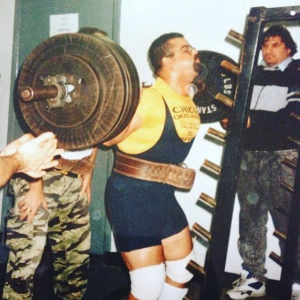 Alberto Velasquez squatting 500lbs circa 1994
Alberto Velasquez squatting 500lbs circa 1994Him pushing that wheel?
Yeah, and then I discovered Muscle & Fitness and I was like, “Man! These routines, I’m not changing!” But through Muscle & Fitness I saw an ad for Powerlifting USA and I saw Anthony Clark squat 1000lbs in the ad and I was like, “Wait a minute! This guy doesn’t look pretty but he’s strong as heck!” And I remember sending the envelope with the money order and I got my first issue of Powerlifting USA and I was like, “Holy cow!” And I knew right away there was a difference between training for strength and training to look good to impress other people, to try to fit into society and from there it took off. That’s how my journey took off. So the original Al’s House of Shred started in 1993 in a basement in Brooklyn. Training by myself twice a week I was able to get almost a 500lb squat and almost a 500lb deadlift. It was tough because I was doing it by myself in my basement. Then my career got derailed because I got hit by a car in Brooklyn that left me with permanent damaged right arm, separated shoulder, broken arm I never was able to reach my numbers again. But then, last February my health issues were out of control. Diabetes, high blood pressure, all of the stuff a middle aged male gets, I was very heavy and I was into powerlifting . The name of the gym was originally at the new place in my house, which I’ve been living in for two years now, The Fat Man’s Barbell Club. So I went on an extreme diet and at this point, I’ve lost 100lbs
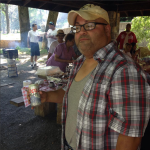

Oh, that’s what’s up!
Yup. Just eating low sugar, low carb diet, just cleaning up myself.
Eating like a grown up.
Yeah, eating normal; trying to regain my health even though I knew it was going to be at the expense of my strength; which I was fine with that. Then my buddy, Dave Wilson, Mr. Wilson or @strathmorebarbell, as a joke said, “You know you should probably call your gym now, Al’s House of Shred!” I said, “You know that sounds pretty good!”
This was like in early March, he was on and off of powerlifting; he wasn’t consistent and he decided after watching my transformation, “If Al could clean up his act what’s stopping me?” He sort of discovered that he loves powerlifting and he wanted to be consistent with it.
Then all of a sudden I had another buddy who was like I’m struggling; the kid’s a natural deadlifter and we’ve been trying to get him to lift for two years and he’s a CrossFitter but he’s built for powerlifting. And that’s Patrick, the Starfish. And we said, “He’s a natural deadlifter; a strong kid but he’s just got to refine his technique.” So then that’s the third member joined. Then my wife said, “I want to get back into it; so this is what we’re doing.” I decided to add a second platform, which is basically two horse stall mats, $40 a pop to protect the floor. Then all of a sudden, a kickboxing instructor named Matt Barnell wanted to join us ‘cause he was like; he felt weak; he’s a martial artist and he just wanted to get big and strong. So I said all right, let’s add a third platform. And then slowly a team started forming. All of a sudden we started building a bond, I got some t shirts made, Al’s House of Shred and people were interested in competing. I decided to do my last meet in April at a lower bodyweight and I just called it a career in lifting and I decided to concentrate training and coaching, mentoring the new powerlifting team that just came together.
If a brand new lifter wants to join the crew what’s your process? Because you’re really letting somebody into your home!
It’s funny that you said that. When Matt Barnell came, Mr. Wilson gave him the look up and down to see if he was serious. Because it has to be serious; it can’t be fun and games. It is called training. But after one or two sessions, Matt Barnell was serious and he said he wanted to be big and strong and he went under Mr. Wilson’s wing and he said, you’re going to listen to me and you’re going to listen to Al. And he was like, “No problem.” For somebody to join us, since we’re not a commercial gym, a stranger no. But a family member or if a team member had a buddy, I would be open. But a complete stranger, no I would not. We’re more like a club; I think that’s the best way to describe it. I think what ties it all together is the freedom of a garage gym and the love of iron.
Click to view slideshow.
So how many members do you have total?
I’d say no more than ten.
Are most of your members around the same experience and strength level?
I see down the road, Mr.Wilson squatting 500 easily. He deadlifted 500 already last August at an RPS meet.
I saw that, didn’t he beat your old record or something? Yeah, he beat my old record of 496, it was in kilos. Our records are personal records, we do it for fun. For our own personal goals. Patrick, he’s a natural deadlifter, he will be deadlifting 600 within a year.
And how much does he weigh?
He’s in the 275lb class. He could easily go up into the super heavyweight. Mr. Wilson is at a light 275lbs, he could lean out to 242 if he wanted to, Mr. Miyagi, Matt Barnell, deadlifted 440lbs weighing in at I believe a light 181. He’s the youngest one. He could probably go after some state records down the road. I’ve got Dave’s brother, another Matt, he’s strong. I’m trying to get him to enter a meet. I think he will enter a meet next year. I’ve got two coworkers here, one is rehabbing his knee through squats and the other one just wants to work on his squat. But the core of the gym is the powerlifting team.
The Set Up
Is this a pay to train facility or is it more of a barbell club made up of training partners who spot each other, give feedback on each other’s lifts and monthly dues to help cover expenses?
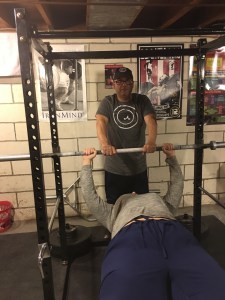 No none of the guys chip in. This is for me a personal thing for the love of the sport and for the love of helping other people reach their goals. No travel fund, we just share rides together. They split hotel costs for the rooms for a meet. One of the guys chipped in and bought some bumper plates so that helps too.
No none of the guys chip in. This is for me a personal thing for the love of the sport and for the love of helping other people reach their goals. No travel fund, we just share rides together. They split hotel costs for the rooms for a meet. One of the guys chipped in and bought some bumper plates so that helps too.
That’s cool. How many square feet you got?
Small house, I think it’s under 1,000 feet. Like 975 maybe.
You’ve got three platforms. How many racks and other workout stations do you have?
I was thinking of doing a short video for Instagram to show people what we’ve got. I have equipment for the guys so they won’t be surprised at a meet basically. Each platform’s got the York Legacy plates, good plates, got Rogue Bars, a nice heavy duty squat stand from, they’re not in business any more, Muscle Driver USA which is really heavy duty. I bought a heavy bench from Rogue with a wider pad so it’s more like a powerlifting competition bench; that helps out with the lifters. I believe it’s a competition height, I have a cheap one and the lifters can tell the difference. Then my B and C platforms I have squat stands which I can move them around and turn it into a deadlift platform. And then all of a sudden we have a Buffalo Bar by New York Barbell and that helps my shoulders now because of my shoulder damage, so I can low bar squat. And then we decided to use it as a bench press assistance and the guys love it for the bench press assistance, the extra range of motion. This is a funny story, I got a good quality B&R bar from Rogue and the guys like squatting in the Rogue Beater Bar which is only $200 but it’s a thicker bar so it feels better for the low bar squat.
How long did it take you accumulate all of your equipment? What did you start out with?
There was just a squat stand, a cheap Olympic barbell and a bench. My training partner was Powerlifting USA. There was no social media. My friends weren’t into it, there was nobody around. One of the highlights for me was I did my first meet and I bombed out and I didn’t want to quit and I just kept going and finally did my second meet and just kept going from there.
I know the process of acquiring equipment is never ending, we’re always finding new toys. What’s next on your “must buy” list?
I just added a Safety Squat bar; I may get a deadlift bar and I’m shopping around; one of my Instagram friends suggested a power rack which I may get. Not sure at this point.
Where do you like to get equipment now?
I narrowed it down to two outlets: EliteFTS or Rogue. New York Barbell is another one, I drive down to Elmira to save on shipping. But I believe if I’m going to train guys for powerlifting, I save up so I can spend the extra money to buy stuff.
The Schedule
You’ve got to work around work schedules and make sure that training doesn’t impact your time with your wife while at the same time making sure your lifters get enough time under the bar during a session and enough sessions per week to improve.
For me training day is Sunday and that’s why we chose Sunday. We lift at around 9 o clock and we usually get done by 11 so we’ve got the rest of the day. Al’s House of Shred only runs on Sunday for the most part. The program basically runs on Sundays here, squat and bench and assistance work for those two lifts. On Tuesdays at Strathmore Barbell, it’s a smaller space. He lives in an older house so the male lifters overhead press in his garage and Thursdays they deadlift in his basement. So basically it’s a three day training week.
Yeah, you’re actually set up with a sister gym, Strathmore Barbell. How does that relationship work? Is it a case of going where the equipment is or a scheduling thing?
 Overhead Press at Strathmore Barbell
Overhead Press at Strathmore Barbell
Absolutely a scheduling thing. Dave is sort of like my unpaid assistant head coach.
When they go over to Dave’s do you still go over there with them?
Yeah, I sometimes go there to coach and to watch them lift and see their technique. Dave’s a very excellent teacher. We bounce a lot of ideas off of each other. He’s a very, I call him the Cerebral Assassin, he thinks a lot. He’s got down the road, looking to become a certified Starting Strength coach. We both have a passion for this.
It’s great because it reminds me of my old basement in Brookly, it’s a very dingy looking basement; and they blast the metal and rap and they just train away.
So my wife is conditioning, kickboxing three times a week and she lifts three times a week. If one of the guys can’t make a regular day at Strathmore Barbell and they want to deadlift here, I’ll let them deadlift here. It’s a little bit flexible. If it was a perfect world, I’d have everybody squat three times a week but it’s not a perfect world, everybody’s schedule, jobs, families are different so the 5/3/1 works out perfectly.
Okay, so your wife is lifting three days a week and the guys are training once a week at your place and the three days at Strathmore. So are the other two days the days you train with your wife at home?
I don’t train with her at home. She trains on her own. I just write out her program. She’s at a point where she can do it on her own with just one basic lift. Being an older lifter, she’s in her late forties,
 Danni enjoys kickboxing along with powerlifting
Danni enjoys kickboxing along with powerliftingwith her I don’t push no volume unless it’s assistance exercises. So for example if the set calls for one set of 240 and this is based off of 5/3/1, I say squeeze out another two or three reps but I don’t push volume because of her being an older lifter and she already does kickboxing three times a week. And with 5/3/1 being so flexible, I can cut out one day if she gets too beat up or increase it if she’s on the money.
Mr. Miyagi testing out the new Safety Squat Bar
Training Philosophy
You guys use Starting Strength and Jim Wendler’s 5/3/1 which are both very popular training templates and training philosophies. How do you integrate the two?
For personal equipment, everybody lifts in Olympic weightlifting shoes , I tried it out myself and I can see why Starting Strength pushes it a lot. I had my lifters train in Chuck Taylors but since we lift raw the conclusion is Olympic lifting shoes works perfectly for the raw lifters.
So you do that for ankle flexibility?
Ankle flexibility and there seems to be a lot of power out of the hole with the foot beign so stable in an Olympic lifting shoe. For example, Matt Barnell, my lightest lifter, he competed last April in Chuck Taylors then he got a pair of weightlifting shoes and he could just tell a difference in the power and how he is stable coming out of the hole in the squat. Doing the deadlift in a heeled shoe, it seems to activate the quad, and I tried it myself, so it feels like you’re pulling the bar faster to lockout. And with a heavy deadlift, for some lifters, the faster you pull it off the floor the better your lockout. That being said, I grew up with lifters lifting in Chuck Taylors or some type of flat shoe so you can get strong either way
I myself when I started lifting; remember this was the early 90s, there was no Internet to find information or anything like that; I high bar squatted because that was the natural way to squat because there was no information out there. I didn’t know about low bar squatting until recently. If you get strong with either style that’s fine. I chose for the team the low bar squat based upon the teachings of Mark Rippetoe’s Starting Strength. And I’ve seen that it works. High bar, does it work too? Yeah! But for everybody here to be on the same page for powerlifting, we choose the low bar. We chose 5/3/1 program for the simple fact of scheduling and we just found that 5/3/1 is more flexible for everybody’s schedule.
Do the lifters get to choose which protocol they follow or do you create their weekly training plans? Like is everybody doing say Boring But Big or does everybody do their own version of 5/3/1?
That’s my three male lifters: Dave Wilson, Matt Barnell and Patrick Vinette. At this point, they were doing 5/3/1 Boring But Big and I believe the next cycle they may change it. The Boring But Big was basically to have a lot of volume and to teach the body the motor patterns of the three powerlifts. The next cycle they’ll bump up the percentages of Boring But Big and then the next cycle they may add more variations of the powerlifts. So for the back squat they may do front squats or pause squats, bench press will be close grip and deadlifts will be either stiff legs or deadlifts off a platform.
Do they do Joker sets also?
I believe that’s coming up but not yet. The foundation of the team is 5/3/1 with different variations. I think it’s the perfect balance. For my wife, she does the basic 5/3/1 for the deadlift and for the squat and bench 5×3 varying progression because she’s new to the bench and she’s new to the squat. And we use the trap bar for her to get more volume in the squat and we use the box to judge her depth being a new movement.
I know that you guys are a tight knit group; I always see you guys cheering each other’s lifts on. How did you build that team pride and sense of loyalty?
You know you read about Westside Barbell, the Westside team and how great they are. I read about Hercules and how they travel as a team other great powerlifting teams I read about and I see how with a team you get better. If you lift with people stronger than you, you will get better and I see my lifters get better from being in that team environment. The team started to build that bond because everybody had that bond it was kind of weird because everybody had the same goal, get stronger, to improve themselves. And my wife likes it. My wife likes the physical changes, I think she was afraid that she had to look a certain way because of society so when I showed her the pictures of the female lifters on Instagram who I follow, I t hink she felt better about herself and realized that society’s got it wrong. We’re a small niche but we’re like an important niche. I’m not crazy about CrossFit but I respect CrossFit and I recognize that there’s a difference between a regular, weekend CrossFit warrior and CrossFit the sport. I do read the articles especially about the nutrition, because as somebody who coaches, I try to learn from different disciplines whether it’s bodybuilding, I try to read Animal’s articles, stuff from Louie Simmons. I try to read so much about lifting in general, how to apply it to my team. My goal of House of Shred is to give back to the sport I love, the sport that taught me a lot about life.
hink she felt better about herself and realized that society’s got it wrong. We’re a small niche but we’re like an important niche. I’m not crazy about CrossFit but I respect CrossFit and I recognize that there’s a difference between a regular, weekend CrossFit warrior and CrossFit the sport. I do read the articles especially about the nutrition, because as somebody who coaches, I try to learn from different disciplines whether it’s bodybuilding, I try to read Animal’s articles, stuff from Louie Simmons. I try to read so much about lifting in general, how to apply it to my team. My goal of House of Shred is to give back to the sport I love, the sport that taught me a lot about life.
Chemistry is so important to a successful team environment. How do you handle it if you have a lifter with a toxic attitude regardless of strength or experience level?
I can tell you this from experience; I had a woman train until recently that, she was becoming a distraction. I think she wanted to lift but not lift for the sake of lifting. I was like that doesn’t work when you’re trying to lift for strength so I basically told her, look you have so many other activities going on, you don’t eat right, you don’t sleep well. You need that. So I told her, “If you’re very serious about this, there’s a couple of places to go, one is with a Starting Strength coach, another one’s Hercules Gym.” She checked them out and eventually she decided to stop coming here. So that’s the way I handled it. And then from there I said to myself, I’ve got to be very selective about who I let come here. Because if it doesn’t work out then you’ve got to be delicate about telling them it’s not going to work out.
Which federations and sports do you guys compete in? Is everyone strictly a powerlifter or do you guys also compete in other sports?
We decided to do two meets a year, August is the RPS meet in Buffalo, NY; we enjoy the RPS so that’s our main meet where we do all three lifts. In April we go to a little AAU meet and we do push/pull. And now this February, we’re going to do a three lift meet right here in Syracuse, at Hercules Gym promoted by Rita West. Just to get the newer guys more experience, test the training cycles. My goal, since I don’t compete no more, is to just share my knowledge and give back to the sport. I take personal pride in the guys hitting their personal records and I’m extremely proud of my wife lifting.
Parting Advice
What advice do you have for someone else who’s thinking about opening up their home gym to the public or even letting friends come train with them?
First of all what type of lifting discipline are you using? Are you powerlifting? Are you bodybuilding? Are you doing CrossFit? Are you doing Olympic lifting? But if you’re doing any of those, your best course of action is a good quality power rack. And the number one reason for a good quality power rack is, if it’s just you lifting, safety reasons. You miss a bench, you miss a squat, you’ve got the pins there. And get one rated for 500lbs or more. A top of the line EliteFTS rack. After that, a good quality bar and then for plates, you can get them used. Craigslist, Amazon. If you’re going to do the Olympic lifts mixed in with powerlifting, you need a good set of bumpers. That would be my advice. No question about it, Starting Strenght is the foundation first and then once you pass the novice stage, there’s plenty of those programs. Brandon Lilly has The Cube, you could toy around with Westside but I always believe whether you’re bodybuilding or powerlifting, you’ve got to get the basics first and those are sets of five in the deadlift, bench and squat. In my opinion, the squat’s the foundation. Because as a lifter, back in the day, if my squat went up, my bench and deadlift went up. And you know, I didn’t realize this at the time but the squat and deadlift trained the same muscles.
Well you know guys like Dr. Ken Leistner were huge proponents of high rep squats!
Dr. Ken Leistner was one of the guys I read back in the 80s. Long Island, used to own Iron Island Gym. I had my first meet there, which I bombed but it was a valuable lesson. The people I read about the authors, were writings by Dr. Ken, I used to read articles by Stuart McRobert,
Oh yeah, his book, Brawn changed my life.
I still have my original copy. And believe it or not, I bought the first version of Super Squats by Randall J. Strossen, I bought that in 89. Brawn I still got my first copy. I bought Hardgainer Magazine. And even today we go through, the Steel Tip by Dr. Leistner, Stuart McRobert, Bradley J. Steiner, Mark Rippetoe, Marty Gallagher. All of those authors stressed the compound lifts. They all stressed recovery. And I realized myself, once I stopped training five days a week, started training two or three days. I cut down my training, I got stronger. A lot stronger. My basic program, again training by myself in my basement was I squatted and benched Mondays, Thursday I deadlifted. That was it and the rest of the days, I tried to recover, sleep well and eat good. And with that training , I pushed my squat up to 500lbs in a single ply suit and 480 raw and I got my bench up to 320. My deadlift was 496 it was in weird kilos. The programs were simple and they worked. I read about Louie too and I think Louie’s Westside system works I personally wouldn’t know how to run it unless Louie was there. Obviously it works, the gym speaks for itself. I watch Mark Bell’s SuperTraining, lot of great info there. One of the biggest highlights was we went to The Arnold back in 2012 and we were in heaven! We met Stan Efferding, The Rhino . . .
He’s a nice guy. I‘ve only met him once but he’s an extremely nice guy.
We met Scott Cartwright, we met Ed Coan. We saw Brad Gillingham hookgrip 800lbs. We saw a blind lifter from Trinidad deadlift over 600lbs. It was awesome.
What about the advice for someone considering letting someone else train with them?
Well you have to consider, have you hung out with this person before? What are their goals? If you’re a powerlifter and he wants to just look good. Little things like that, I guess the best advice is you’ve got to go with your gut. If your gut tells you this is not going to work out then don’t do it. And me and Mr. Wilson, we don’t charge anything; we’ve had coworkers ask for help but they don’t follow through so we don’t push it or anything.
 I’m a big follower of The Art of Manliness and I listened to a podcast from them about The Rise of The Sufferfests and why that’s happening. I think it’s because most people in our culture aren’t challenged physically. We’ve got the War on Terror but most people aren’t involved in the War on Terror, they don’t have physically challenging, fulfilling jobs so I think as humans we’re designed to overcome challenges and that’s why I think that what you’re doing is huge.
I’m a big follower of The Art of Manliness and I listened to a podcast from them about The Rise of The Sufferfests and why that’s happening. I think it’s because most people in our culture aren’t challenged physically. We’ve got the War on Terror but most people aren’t involved in the War on Terror, they don’t have physically challenging, fulfilling jobs so I think as humans we’re designed to overcome challenges and that’s why I think that what you’re doing is huge.
I’ll use Dave Wilson as an example. He’s done deadlift training on some nights after doing a 12 hour day, but he has to do it. It’s that inner, it’s that thing inside of you. He wants to get better, he had a goal. He wanted to deadlift 500lbs. Most guys I know wouldn’t do that! I had to battle personal demons because I had given up on life earlier. That’s why I was morbidly obese. I had a drinking problem. The doctor tells me, you’re eating yourself to death. I shouldn’t live to eat, I should eat to live and once I changed my mindset, I dropped 100lbs. It’s the balance of yin and yang as a lifter. And I reached some goals as a lifter. I squatted 500lbs in a single ply suit back in 1994, I almost had a 500lb deadlift but it is what it is. And I think when I got hit by a car, maybe God had a plan for me. I should have been dead. I think that there’s a bigger plan for me and that’s training my wife, that’s helping Mr. Wilson reach his goals, helping the Starfish, Patrick Vinette reach his goals, Mr. Miyagi, my youngest lifter, reaching his goals. It’s helping my coworkers and that’s the purpose for me. Is to help people, to help them understand. I have to keep active, if that means just lifting once a week and walking, well then so be it.
The post Garage Gym Showcase: Al’s House of Shred appeared first on Garage Gym Life.
July 18, 2017
marcbewegtschwereszeug= Marc Moves Heavy Stuff
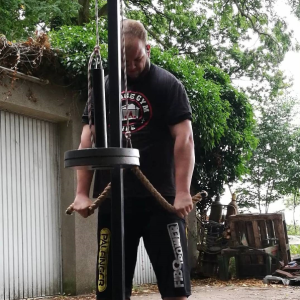 marcbewegtschwereszeug
marcbewegtschwereszeugMarc Wittrowski is a strongman who I discovered last year on Instagram while he was playing amateur American football in his native Germany. He’s got a ton of cool pictures and video of himself lifting and carrying heavy loads in a backyard in Germany. A year later, with one strongman competition under his belt, Marc is fully committed to using that backyard gym to improve as a competitive strongman; building a lot of his own equipment and traveling to work with top trainers to improve his technique. Read more about how Marc moves heavy stuff below.
Before we start, what does your Instagram name mean in English?
marcbewegtschwereszeug = marcmovesheavystuff; marc = my name bewegt = moves schweres = heavy zeug = stuff
How long have you been training? Where did you get your start? (your parent’s basement, a commercial gym, high school weight room etc.)
I’ve been playing American Football in Germany for about 5 years now.
What position do you play in American football?
I played Defensive Tackle for the first year, changed to Offensive Line for about 3 years. This season I came back to Defensive Tackle. In the picture below I’m number 76. But this season is my last one. I want to go on the journey to strength (“wegzurkraft”).

So wegzurkraft is Journey to Strength? That’s cool! How did you decide to begin doing Strongman?
During the 2015 season I injured my right knee and right ankle. While in rehabilitation I saw some YouTube videos from “Strength Wars” – the series where 2 athletes compete in strength exercises. From Strength Wars I came to Strongman.
Where in your house is your gym located?
In 2015 I had different bars, some plates, a platform with bench and squat stand in the basement of our house. In April 2016 I got the chance from a good friend to use a part of his garage and his farm for my training for free.
Training for football and training for Strongman are similar but different at the same time. Are there any things that surprised you about the training when you started doing Strongman?
It was hard to train for Strongman and Football at the same time. During the week I trained up to 7 times. Every end of the week I could feel the missing power and concentration. Both sports at the same time is too much for my body. During the season every week is Game Week, I couldn´t really train on a high level with high weights. This is not the way I want to train, so I now I concentrate on Strongman.
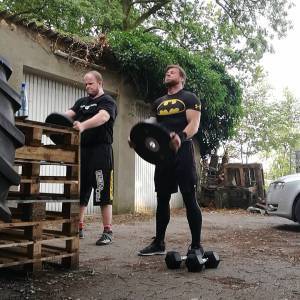 Over the last year friends came and trained with me in my garage gym
Over the last year friends came and trained with me in my garage gymYou’ve competed in your first strongman competition since we spoke last year. How did it feel to realize your dream?
All in all it was great to compete for the first time. I have learnt my lessons from this first strongman competition. The weeks before the comp I ate too much and while we competed my body felt really heavy and not in the shape that I expected.
I trained the events over and over BUT I was nervous and don´t focus enough at the first two events on the right technique so I lost my power really fast! Overall I had fun, got a new axle-deadlift pr (8x200kg), met new people and realized that I have go back to my garagegym and train harder to be better prepared for the next competition.
marcbewegtschwereszeug (and makes it too!)
Garage gyms often start out barebones. Especially when you do a sport like Strongman where you can’t always buy what you need. What did you start out with?
Strongman equipment is very expensive but I when I compete in Strongman. So I started to build this equipment on my own. All pieces of equipment from my pictures and videos except the Oly lifting bar and the plates are DIY. Building gym equipment is the best part besides the training itself. Because of the limited space I try to build equipment which I can use for different things. It´s a “invite only/private gym” and over the last year a couple of friends came and trained with me in my garage gym and all of them were surprised by the quality work of my self-made equipment.
So where did you buy the Olympic lifting bar and the plates?
The equipment that isn´t DIY is from Strengthshop.de and Ebay.
Okay. So back to how you got started with making equipment.
In the Football preseason 2015 I tried to develop a better punch on the line. So I decided to build a different barbell for bench press. The role model was the Rogue Multi Grip Bar. This worked very well. So the next steps were my DIY Fat pad bench and my DIY squat stand with spotter arms.
was the Rogue Multi Grip Bar. This worked very well. So the next steps were my DIY Fat pad bench and my DIY squat stand with spotter arms.
What have you added to casa marcbewegtschwereszeug since we spoke last?
I upgraded my squad stand to a full rack. Added suspension bands for squats and benchpress.
I reworked my yoke (+ added a vikingpress adapter) and build new farmers walk handles with the option to use them for framecarry.
I added two machines: a lat pulldown tower (option to do T bar rows) and a reverse hyper (option to do rows and dips). At the beginning I never wanted machines but now it´s nice to have them, especially the reverse hyper is a great piece of equipment.
I added many special bars: SSB, Camberbar, 50 mm Axle, 60 mm Fatbar, Rogue Deadlift bar
I added a lot of strongman stuff like Apollon wheels, sandbags, atlas stones, logs and circus DB.
I tried to build my own dumbbells but decided then to buy them. My hex dumbbells range from 10 to 50 kg.
How did you learn to make your own equipment? Have you always worked with metal or did you learn so you could build your own gym equipment?
At my education as an industrial mechanic I learned all the skills I need to create equipment.
So what led you to train where you train? I saw on Instagram that you wanted to leave Gold’s Gym but like you said, Strongman equipment is expensive. Aren’t there other gyms where you could train; you train at CrossFit Amboss sometimes don’t you?
The Gold´s Gym from the IG pic wasn´t my local gym, I trained there while a business trip. At the Gold´s Gym and my local Gym I can´t train the way I like to. At the basement gym there isn´t someone who wants the squat rack, the bar or the plates. I can train 24/7 and when I drop the weights nobody comes around the corner and admonish me that I shouldn´t do that. Sometimes I train at Crossfit Amboss. This is a Crossfit Box managed by two friends. I build up there Rig and have made them 2 Log Press Bars. It’s a distance of one hour driving and they do Strongman classes once a month.
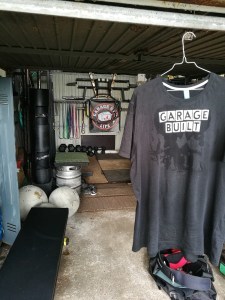 cof
cofSo who is Johannes Luckas and how does he fit into your strongman training?
Johannes isn´t my trainer. The plan is made by me and my friend (Personal Trainer at Crossfit Amboss). It´s inspired by other powerlifting and strongman athletes that I follow on YouTube and Instagram. Johannes Luckas is one of the best personal trainers in Germany. He lives in Berlin this is 300 km one way to my hometown. This weekend in Berlin was my vacation this year. I had two hours with Johannes this year to let him check my deadlift, squats and bench press.
Some people might be afraid to start their own gym because they might not know how to build equipment. What advice would you give to anybody who is thinking about starting a gym in their home?
KISS = Keep It Simple Stupid. Start with simple equipment. Know what you need and make some plans / drawings about it. Don’t be afraid to ask other people to help you. For example my dad helped me a lot; he knows the old school way to form metal.
How is your family involved in your fitness journey?
My mom says every time that I shouldn´t do this heavy things. She thinks that I get too big! My dad is proud that I put hard work into my dreams.
How can people follow your training?
Follow me on Instagramm marcbewegtschwereszeug – I made this for my journey to strength
Outstanding!
The post marcbewegtschwereszeug= Marc Moves Heavy Stuff appeared first on Garage Gym Life.
July 15, 2017
Garagegym107 Owner Michelle Simpson
Garagegym107
Garagegym107 founder Michelle Simpson was the third home based athlete to share her Iron Journey with us and the first garage gym business owner. She wears a lot of hats: Wife, Mom, Nana, Sister, Weightlifter, CrossFitter and blogger. She lives by the motto, “You’re never too old to reach for amazing” and she’s proving it. A former Body for Life champion, Michelle has competed in a strongman show and coaches at a local CrossFit box and online as a certified Precision Nutrition coach. That’s on top of a full time professional career! Many people would struggle to balance all of these competing interests but she manages it with smart planning and training in an at home facility called Garagegym107. As her YouTube channel says, she is motivated by sharing a strong love of fitness, weight loss, and motivation to help other women her age realize that they’re never too old to reach for amazing! Let’s get to know this cool garage gym athlete!
Michelle, as I said, you’ve got a lot of different things going on. Do you train for all of them at Garagegym107?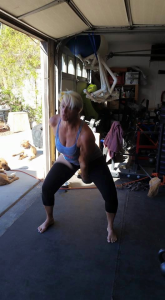
I do most of the time. I also train at the CrossFit box I coach for; usually at 4:30 am before I coach at 5:30.
You’re a CrossFitter and weightlifter; do you normally stick to barbell and kettlebell work or do add machines into your garage workouts as well?
I do some unilateral work in my work gym during my lunch hour. Good old fashioned body building. It prevents me from punching people in the face, just saying!
I know a little bit about you from reading your blog at Garagegym107 but for the benefit of our readers, what is your story? How did you start training?
15 years ago, I was morbidly obese. I took a fall down a flight of outdoor stairs and didn’t even know if I was ok. I was fat, lonely, and depressed. I met someone who handed me a book called Body-for-Life by Bill Phillips. It was a game changer for me! I read the book from cover to cover the weekend I bought it and I followed the guidance in the book to a T.
But I was so heavy and out of shape! I began exercising and always felt shy and uncomfortable in the gym. I felt like people 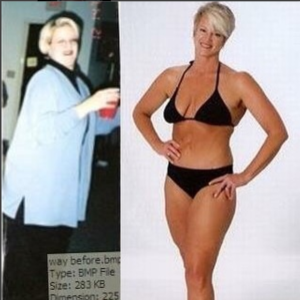 where always staring and laughing on the inside. Little did I know, most all of them were cheering me on. After about 10 weeks of following the program I realized I wasn’t going to be an “after”. Well, not in 12 weeks. I had a complete and total melt-down. I sobbed and sobbed, then the doorbell rang and the brown truck delivered a package. That package contained a video called Body of Work . I watched it through my tears in the beginning. Then I decided I could quit or keep going. There is no quit in me, not then and not now. I successfully lost 125lbs the first year.
where always staring and laughing on the inside. Little did I know, most all of them were cheering me on. After about 10 weeks of following the program I realized I wasn’t going to be an “after”. Well, not in 12 weeks. I had a complete and total melt-down. I sobbed and sobbed, then the doorbell rang and the brown truck delivered a package. That package contained a video called Body of Work . I watched it through my tears in the beginning. Then I decided I could quit or keep going. There is no quit in me, not then and not now. I successfully lost 125lbs the first year.
Fast forward 8 years, I took a job with a different company and the elevator doors where mirrored. After my initial weight loss I became complacent where is was. Those elevator doors closed and before too many days had passed, I realized I had more work to do. I had gone from obese to average, then it was time to become extraordinary. I lost the remainder of the weight, submitted my contest packet to EAS/Abbott Laboratories and officially entered the Body-for-Life Challenge. Eight months later I got the call letting me know I had won the 46+ category in 2009. And my photos are on the Internet forever.
In 2010 a friend said “Hey, you should try this thing called CrossFit!” and I fell in love with a new level of fitness. In 2011 I became a CrossFit L1 Coach. Maybe it was the weight loss, maybe it was turning 50. In the fitness industry, I’m definitely a Master’s Athlete at 53. I feel like I am in a race with old man time. But I am a firm believer that age is just a number.As long as I stay one step ahead, I am successful. I refuse to settle for status quo.
What advice would you give someone who’s setting up their first home gym?
I bought my equipment one piece at a time over the course of a year. I bought scratch and dent equipment when I could. Paint the walls, put motivating posters and join the online community. You can have all the equipment money can buy, but you can’t buy discipline! Get up and put out! I live by the motto “You’re never too old to reach for amazing!”
It would be so easy to rest on your laurels; how do you stay motivated to train?
Helping others reach their goals by setting the example. As I progressed I had the calling to help others realize you can’t out train a poor diet. I looked near and far and settled on Precision Nutrition for my certification. I spent the next 3 years completing both my Pn1 and Pn2 certifications. I now offer on line nutrition coaching using the Precision Nutrition ProCoach Software.
 Looking ready for action in the Garage Gym Life Women’s Organic Logo T
Looking ready for action in the Garage Gym Life Women’s Organic Logo THow can people get in touch with you to take advantage of your services, to train with you at Garagegym107 or even just follow you on social media?
For online habit based nutrition coaching contact me at: garagegym107@gmail.com.
Instagram: @garagegym107
You can also follow Michelle at her blog GarageGym107 for an inspirational and introspective peek into her life and philosophy.
The post Garagegym107 Owner Michelle Simpson appeared first on Garage Gym Life.
July 14, 2017
@advenracerchick is IndaHouse!
@advenracerchick is Inda House! Marisol Inda is a true Renaissance woman. She’s a career teaching professional, a competitive endurance sports athlete and a full time parent! With all of that you might wonder when she gets time to train! As you’re about to find out, she’s able to juggle her work/life and fitness goals because of her ever evolving garage gym. Check out the story of this awesome lady who was the second person to share her Iron Journey with garagegymlife.net!
@advenracerchick Multi Sport Athlete, Professional and Super Mom
Marisol @advenracerchick Inda! I’m glad we were able to do this! I mentioned that you’ve got a number of different athletic interests. What sports do you compete in?
Competing in kayaking, cycling and running is what I am passionate about now. I want to do a power lifting meet; that will be my next endeavor!
What’s the biggest sporting event you’ve competed in?
The biggest sporting event I have competed in was the three half marathons I completed.
Marisol, you’re a school teacher right? What grade do you teach? How long have you been teaching?
I am an English high-school teacher with 17 years in the profession!
17 years! That’s awesome! And you’re also a parent. How many kids do you have?
I am a parent of three great kiddos. My son who was born with Cerebral Palsy is 17 and my angel. I have twin daughters age 9 whom continually demonstrate what it means to have a beautiful heart.
You’re juggling three kids and a teaching career? Wow! With the many things you’re interested in, plus the responsibilities of being a parent and a teacher how does @advenracerchick maintain a balance?
Maintaining balance is so important in order to live a happy life. It’s critical to keep the body physically fit and to be that role model for your children. Working out for me is my haven!
How long have you been training? Where did you get your start?
I have been training since I was in high school where I lifted weights and competed in running. Since I am now 43 that has been many years of physical fitness love!
Where do you normally train? I know you’re about that garage gym lifestyle, where in your home is your gym?
 I think it is imperative to implement strength training with all endurance type sports!
I think it is imperative to implement strength training with all endurance type sports!I train in the good old garage and I love it!
Why does training at home appeal to you more than training in a commercial gym or even a CrossFit box?
The appeal of training at home versus a commercial gym or even at a CF box is TIME! I don’t have to apologize or feel hurried to get off the squat racket any other apparatus. All the equipment is ALL mine whenever I want it. Having that freedom allows for more intense and longer workouts if I want!
What about kayaking and cycling? I’m guessing the kayak doesn’t fit in your bathtub (but if it does we want pics!) so are there waterways and riding trails near your home where you can train?
Living in Houston, Texas allows me to train for all my sports year round, although time adjustments have to be made in the summer because it gets so hot. I live close to the Gulf. So hitting a bayou, lake or the ocean is not a problem. The bike trails are also amazing from novice to easy riding!
How has the garage gym evolved since you first started training at home?
 I live close to the Gulf so I can train all of my sports year round
I live close to the Gulf so I can train all of my sports year roundCollecting equipment has been made easy with companies that are seeing the need for people to acquire quality gym material at a reasonable price point.
Where did you get your equipment, did you buy most of it or go the DIY route?
I have acquired most of my equipment from GetRX and some pieces have been ideas that have come to fruition through heading to Lowes!
What’s your dream piece of equipment? The one thing that you don’t have but you really want to get?
I dream about having a complete dumbbell and kettle bell set.
You’re unusual in your love of strength training. Typically, endurance athletes tend to not enjoy strength training as much as their cardio sessions. Do the different types of training appeal to different parts of your personality?
I think it is imperative to implement strength training with all endurance type sports. Lifting weights only aids in growth in the other sports. My personality is one of wanting to try it all; I enjoy a challenge!
Some people find it difficult to train at home even with a partner. How do you stay motivated? Is there somebody who inspires you to train?
My sister, Marisa, is the person who inspires me. She is a power lifter who holds world records and is very accomplished in her sport. I have gone to see her compete and have been overwhelmed with emotion because I know the amount of training she has put in. Her motivation and attitude are inspirational! But my motivation to keep on training is my pure love for being physically fit! Seeing growth and gains keeps me pumping the iron.
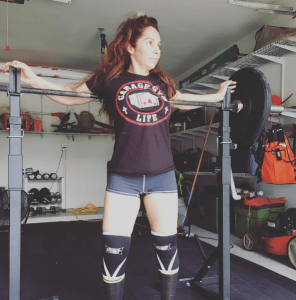 What advice would you give to someone who’s thinking about starting a gym in their home?
What advice would you give to someone who’s thinking about starting a gym in their home?
My advice for anyone starting a home gym is to be patient! Collecting quality equipment takes time but the rewards at the end are well worth paying that membership fee at a commercial gym!
How can people follow your training or get in touch with you?
If anyone would like to follow my journey I am on Instagram @advenracerchick! I would love to connect with like-minded individuals!
Do you have anyone you want to thank before we sign off?
I would love to thank my sister for always being there for me and being my hero!
Thank you for taking time to talk to share your story with us!
Thank you for interviewing me!
The post @advenracerchick is IndaHouse! appeared first on Garage Gym Life.
July 13, 2017
Get To Know Nigerian bodybuilder Azekhumhe Omoh
Who is Azekhumhe Omoh?
Azekhumhe Omoh was the first home based athlete to be profiled on garagegymlife.net. Since our conversation, he’s gone on to bigger and better things, but has never lost sight of his hardcore, backyard gym roots! Find out his story in our original interview.
Azekhumhe, thank you for taking the time to let us know about the West African bodybuilding scene. We see the motivating videos of you guys training but there’s very little background information on African bodybuilding. I know that the readers are eager to find out about you guys so let’s dive in!
How long have you been training? Where did you get your start?
I have been training for 5yrs now. I started at home then it was just one little cement dumbbell I had.
Where is your gym located? Is it at your home or a friend’s house?
The gym is located at my house.
Did you all build your equipment or did you get someone to make it?
We built most of the equipment ourselves with a well measured amount of sand, cement and gravel for the weights but we have to make a sketch and provide the resources needed for the metal equipment like the Squat rack, T-bar and the Squat bar.
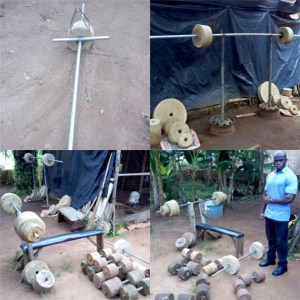
Which piece of equipment was your favorite to make?
The dumbbells; it is one of the most important equipment in the gym and also one of the hardest to make locally. But no matter the size I am building, I always pay full attention to every detail when I am building it; from shaping to casting and installing it all has to be accurate.
Cement dumbbells are pretty hardcore! In the West, we’re pretty insulated from the problems of the rest of the world. Even I, as an immigrant from West Africa have only vague memories of what it was like in my birth country. Bodybuilding is hard enough when you’ve got all the resources we have, I can’t imagine how it is for you guys. So tell me, what’s your biggest challenge?
Growing up and surviving in this part of the world is a very, very big challenge with the whole political and economic thing going on, only the rich one’s and the strong one’s like me and my fellow garage gym brothers and sisters all around the world will survive. My biggest challenge is not having money to buy good food to eat. As a fitness person or weight trainer your body needs a lot of good nutrition to help repair the muscle after training, but getting money to buy the necessary food and supplement we need is a very big challenge. Countless times we have trained on empty stomach without food not even a little biscuit. But still God’s grace and the passion for what we love kept seeing us through and helping us push pass each day.
I hear what you’re saying but I see the awesome videos of the physiques that you guys are building in Ghana, Nigeria and other parts of Africa. West African bodybuilders are making a lot of progress despite limited resources. What is the secret to making progress despite your obstacles?
For me, the secret is the ability of being able to see the great opportunity we have in every moment of each day we live against all odds. Knowing that the sorrow and the pains we feel now will only last for the night, but joy must surely come in the morning.
Let’s go back to nutrition. We’ve been reading a lot in the past few years about the health benefits of red palm oil which is used in West African cooking. When you are able to get food, which of the traditional African foods play the biggest role in helping maintain your physique?
Beans with bread or grinded cassava, white rice with palm oil stew, vegetable soup with ground cassava, fried beans with bread then fried eggs with bread.
In the West, our problem isn’t lack of food but too much intake of bad foods. When you’re limited nutritionally, it’s got to be tempting to eat anything you can get but are there any f
oods you absolutely have to avoid?
The ones with too many starch and fat.
Where do you get most of your training information?
I do a lot of research and I watch videos that have to do with fitness training in general.
Who inspires you?
My inspiration comes from people doing things that other people says they can’t do no matter how hard they try.
How do you stay motivated to train?
Each time I look at the way we are living trying to survive with no money, nobody to help you, no friends just me my family and the gym I feel my blood pumping and my spirit rejoicing knowing that each time I bench, squat, dead lift or curl I get one little step closer to saving my family and all my brothers in the same struggle in one way or the other.
Do you and other West African bodybuilders ever get together to train?
No, but I hope so in future.
Azekhumhe have you done any competitions?
No.
What advice would you give to someone who’s thinking about starting a gym in their home?
Let absolutely nothing discourage you! The beginning may be tough, but when you are able to resist negative ideas, then the sky is just the beginning. If you really love it then go for it no matter what!
If you really love it then go for it no matter what!
How can people follow your training or get in touch with you?
They can follow me on:
Instagram: @oazekhumhe
Facebook/AzekhumheOmoh
Twitter: @azekhumheo
Like my Facebook page: Normal sucks
Email: omoh4pk@yahoo.com
Thanks again for answering my questions. Your story is pretty inspiring to me and I’m sure that others who read it will be inspired as well. It’s easy for us in the West to get wrapped up in our personal problems which is why it’s so awesome to read about someone who’s facing their struggles head on every day. God bless you Brother and keep pushing forward!
With much love from Africa Thanks Bro.
Since this interview, Azekhumhe has been sponsored by I Will Strength Apparel, a manufacturer of inspirational apparel founded by Metholamus San who fled an oppressive regime in his native Cambodia to start a new life in the United States. We believe that this was a great match for Azekhumhe and we are proud of him! Support these guys and Azekhumhe by visiting www.iwillstrength.com
The post Get To Know Nigerian bodybuilder Azekhumhe Omoh appeared first on Garage Gym Life.
July 3, 2017
AnnieLori Thompson: Strong to the Finish
 Who is AnnieLori Thompson?
Who is AnnieLori Thompson?AnnieLori Thompson is one of only two athletes I know of who combine strength sports with ultra long distance running. Annie Lori (yes, she’s so strong that her mom gave her two names!) is an ultra-marathoner, powerlifter and strongwoman competitor! That is an awesome combination that made me want to know more about this Garage Built powerhouse!
How long have you been training?
For running, a little over 9 years. For strongman/powerlifting, about a year and a half.
Would you say that you’ve experienced more success in endurance events or strength events?
That’s a tough question. I would say that as far as endurance events go, I was very successful in terms that I completed most of my events when I toed the start line. I achieved each distance that I took on, and in my book that’s success! I am fairly new to the world of lifting, however, I feel like I am getting to a point where I set personal goals and PR more frequently.
How Awesome is AnnieLori Thompson?
AnnieLori you’re competitive in so many cool ways. Let’s break down your stats and talk PRs:
Squat 195 LBS
Bench 115 LBS (see the video here)
Deadlift 275 LBS
I saw a video where you loaded a 195lb stone. Is that your best strongwoman event?
YES! I love loading stones!
And last but not least running, what’s your best 50k time?
5:43 on a trail.
Do you do obstacle course races?
I have done some in the past, and they are fun! I’m not against doing them, I just prefer the peaceful trails nowadays.
You’ve got a pretty impressive rack of medals and trophies. What are some of your favorite memories from your competitions?
My first 100 mile race is my favorite to date! My husband was at the finish line waiting for me, and my pacer was along to push me the last 15 miles were highly emotional. I remember thinking,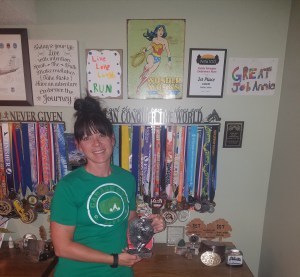 “Holy crap, I am really doing this! I am running 102 miles!” My last 2 miles were sub 8:00 miles. I left it all out on that course.
“Holy crap, I am really doing this! I am running 102 miles!” My last 2 miles were sub 8:00 miles. I left it all out on that course.
My first Strongwoman competition was so special, because my brother was so proud of me. For me, that was what was important. I took second place in LW Novice.
At some point in a meathead’s lifting career, they become obsessed with picking up random stuff they encounter in the world. I’m pretty sure that’s how the Manhood Stones around the world first became a thing. Do you ever see a large rock while you’re out on your runs and sort of mark the location so you can come back later and try to lift it?
HA! I actually have moved downed trees on the trail, it comes in handy. We do look at random objects along the way and make comments about me lifting them. However, I am very respectful to nature, I tend to not upset the balance. Plus, you never know what critters are living under stuff!
Good point. Nothing like a snake to kill the mood so to speak.
Training, Nutrition and Consolidation of Stressors
You said that your running style is better suited to trail running than road racing or running on a track. Talk about why that is and how the readers could figure out which way is better for them.
My body type is much more muscular. Trail running is full of rocks, roots, varied terrain, big climbs, and obstacles. Because of that my muscular build really suits those environments. In road running my main focus was always SPEED, being thinner, losing weight to get faster. During the time I first started running, I fell back into my eating disorder. Once I found trail running, and that I needed my muscle to pull me up climbs and climb rocks, I really shifted to taking on food as fuel. Road running also beat the heck out of my body. The softness of the dirt trails absorbs a lot of the shock, saving my hips, knees, and lower back.
 I asked you this during your Facebook Live session with Anna Woods of sheStrength, but for the sake of those not fortunate enough to catch it, describe to me the difference between how you gear up mentally for a long training run versus a lifting session.
I asked you this during your Facebook Live session with Anna Woods of sheStrength, but for the sake of those not fortunate enough to catch it, describe to me the difference between how you gear up mentally for a long training run versus a lifting session.
Long training runs, I can pace myself and continually move without stopping. Mentally that’s what drives me, the push to continue in a forward motion. In lifting, I have to be prepared for a max pull, stop, regroup, start over. Each definitely require a different mindset. My lifting days require more patience, because some days you can’t find the right groove. Running is finding a groove, sticking to it, and just rolling with it.
Most of what I know about ultra-marathons and long-distance running comes from watching Finding Traction on Netflix. (which you should definitely watch if you haven’t.) I noticed that on long runs spanning days, a lot of notions of “clean eating” are out the window and runners go by cravings almost. You said though that you prefer whole foods, oatmeal etc. How long has it taken you to develop your refeed strategy for races?
It took me about a year to find the correct balance of foods for my GI tract during long events/training runs. As a road runner, I took in GU packets, Clif shots, and only water on the course. Since I took up trail running in 2013, I never looked back. It took me getting into 31 miles, 50 miles, 62 miles, etc. to get into the groove of electrolyte and nutrition balance.
As an ultra-marathoner, I’m sure you’re familiar with Chris McDougall’s Born to Run. What’s your viewpoint about minimalist running shoes versus the traditional thick soled trail shoes?
My husband loves minimalist shoes, and they suit him well. It takes time to actually transition to minimalist running, and I know many people who have been quite successful with it. I am not able to run minimalist, because I had reconstructive foot surgery two and half years ago and require protection for the screw in my foot. I think minimalist running can help a lot of people run with better form, if they transition correctly.
Do you buy your shoes a couple of pairs at a time or just replace them at regular intervals throughout the year?
WE HAVE SO MANY SHOES! We order 2-3 pairs at a time. I have indoor (treadmill) shoes, several pairs of trail shoes, and then road shoes. I hardly ever run on the road, but when it rains, we stay off of the trails as to not damage them.
Finding Balance
A lot of runners have a hate-hate relationship with weight training; they don’t want to add any extra weight that will slow them down or add pressure to joints that already 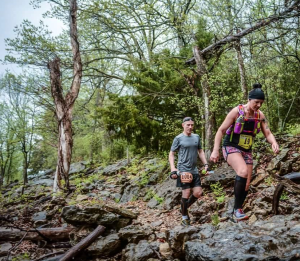 take a regular pounding. Talk about how you figured out a way to make your two separate training lives complement each other.
take a regular pounding. Talk about how you figured out a way to make your two separate training lives complement each other.
This is so true. The sad part is, every runner should lift weights and they ignore that. It’s really crazy actually, since I began lifting heavy, my recovery time after endurance events is like 2 days. My legs do not tire as they once did. Climbing hills is way faster now, because deadlifts and squats. I figured out that the balance of both works for me, and that I can have the best of both worlds.
But we’re talking serious mileage here! 100 mile events are not your local 5K race. In fact, you and The Hybrid Athlete author Alex Viada are the only strength athletes I know of who also do long distance running. How do you structure your training and competition calendar each year so you can give each discipline the attention it demands?
Since experiencing a TIA during a 100 mile event in December 2015, I train shorter runs with higher intensity 3 days a week, and a longer run on the weekend. I lift 3 days a week, so I try to run those 3-4 days a week when I have a race on my calendar. Right now I am training for my first powerlifting competition, so running takes a back seat for true recovery days. I think the balance has become easier, since my body is adjusting.
So how far apart do you have to schedule running and lifting?
I think for me I have just been really honest with myself. My body lets me know when I am doing too much, and it’s not quiet about it either! Some days I pull two-a-days, running in the morning and lifting in the evening. It works for me now, but at first, it was rough. For the most part I alternate the two. I may run Monday, Wednesday, Friday. Lift Tuesday, Thursday, Saturday and rest on Sunday.
That’s pretty intuitive; training along with your natural rhythms is a lost art I think. I see that you’re also doing a good job of what Chad Wesley Smith calls Consolidation of Stressors. So is being successful in the three different sports dependent on nutrition or getting adequate rest? I ask partly because you teach nutrition but you also confessed to not getting enough sleep.
In a perfect world, I would get more sleep. I have never been much of a sleeper. So in all honesty for me personally, I rest an adequate amount for me. I always say nutrition is key to fueling and repairing muscle. You can’t eat like crap and expect to feel amazing, that’s just not realistic.
Everything you do is a hobby sport meaning you also have to hold a full time job. Plus you’re a wife and mother. It seems a no-brainer that a home gym would be part of your strategy for maintaining balance; but you primarily strength train with your brother, Strongman competitor Jobe Jesse in his garage gym. That’s a lot to juggle! Do you schedule an off season like bodybuilders do so you can focus on your family without the demands of preparing for competition?
I am extremely lucky that my brother provides my programming, coaching, and gym for me to train. (We also have a home gym that is in the works.) I do not take an off season. Movement is essential for me to be balanced. My husband is also an ultra runner, it’s a love we share.
The Jobe’s Steel Jungle Advantage
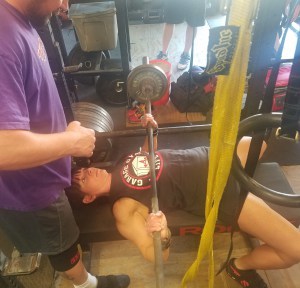 Training with my brother comes with an awesome support network!
Training with my brother comes with an awesome support network!
A huge advantage of a garage gym is the convenience of just going downstairs to train. Because you train in someone else’s garage gym, you’ve still got to factor in the commute. What are the advantages to you of training in Jobe’s Steel Jungle versus just setting up your own facility at home? Is it to avoid “taking work home with you” so to speak?
We are building our gym as we speak! It’s so exciting! My brother lives 5 miles from me, so it’s relatively close still. I have ran there before a workout before as well. I really enjoy the time with my brother and the other athletes that train with us, so the time at The Steel Jungle is also social for us. The guys are all very supportive and offer a lot of advice and tips to better my lifting. I feel pretty blessed to train with all of them, they’re all like family.
Your family is pretty active; your husband and kids run with you. Do they ever venture over to Jobe’s to lift with the crew?
Our children also spend time at the gym with us, so really we have made it a part of family time. My husband is now lifting as often as 3 days a week, if possible with his demanding work schedule. And the kids are really getting into it! My 11 year-old daughter wants to compete.
Refuel, Recover, Repeat
 My daughter and I after her finish of her first 5 mile trail run!!!!
My daughter and I after her finish of her first 5 mile trail run!!!!How do you refuel to stay healthy?
I eat 6 times a day on training days and calculate macros to make sure I get enough protein, carbs, and fats. I also see a chiropractor weekly, and get massages bi-weekly as part of my wellness routine.
What are your go to recovery methods the day after a race or a lifting competition? How long before you’re back to training?
I do Epsom salt baths, use a TENS unit, and get sports massages. I love massages! I typically rest 3-7 days before I return to workouts.
Along with that, how often do you deload your strength and endurance training?
I usually have 8-week cycles of strength training. I typically deload at the end of each cycle. My endurance training, I actually keep my mileage fairly low until I register for an event. I build up distance weekly, then taper down 2 weeks prior to the race. Post event, I take a full week off from workouts overall.
Building Her Home Gym and Goals
So you said that you have a home gym in the works. How is that coming along?
We just bought a Rogue squat stand, it’s on its way!
My brother and I trade back and forth across training cycles and it doubles the available equipment. For example, he’s using my axle bar to prep for a competition and I’m using his Fat Gripz on my dumbbells and pull up bar. We just traded out Atlas Stones because I wanted a smaller stone I can use for longer conditioning walks but he wanted another heavy stone. Do you plan to do the same thing with Jobe?
Sometimes I do borrow some pieces of equipment from my brother. He has quite the collection! I wish I had the space to have as many bigger pieces as he does, he really has the ideal setup. Since he does all of my programming, it’s just nice to have him coach me at his gym!
Meantime according to Instagram, you already have a Concept 2 rower. What role does it play in your overall training plan? Is it a recovery tool or another way to sneak in some conditioning?
It’s totally for conditioning! It’s a crazy good total body workout!
What are your goals for the rest of this year?
My goals are to compete in my first powerlifting meet, compete in 2 more strongwoman meets, run a few 50Ks, and a 50 mile in December. My brother Jesse and I are running a 5K this month together for fun! (He hasn’t run since high school.)
I’m definitely going to need video of that! Do you have any sponsors or people you’d like to thank?
I do not, but I would like to thank my brother, Jesse, for all he does for me. Having his support really gives me confidence. Plus, all of the guys at the gym…they’re alright. Also, thank you John, for taking time to support every one of us garage gym athletes!
It’s my pleasure; as a young company we struggled with whether or not to sponsor athletes or reach out to influencers with a following as most brands do to build awareness. We just felt that the Lord was leading us to instead just try to build real relationships with people who are living this life and trust that they would in turn trust us enough to take a chance on the products we sell. That being said, it also inspires me personally to see you guys train so I love checking out videos on social media of people killing it!
But enough of my rambling; how can people follow your training or contact you if they need nutrition or training advice?
My Instagram @annielorithompson, people may always message me on Facebook or send me a request as well, or my email anniewalton25@gmail.com. I am currently building a website as well, and that is very exciting!
The post AnnieLori Thompson: Strong to the Finish appeared first on Garage Gym Life.
June 27, 2017
Bobby Allen: Husband, Father, Bodybuilder
Bobby Allen is a husband and father with a full time job. He’s also a competing bodybuilder, building a stage ready physique with daily garage gym sessions. I caught up with him to find out how steel eaters train!
Bobby how long have you been working out?
I have been working out since I was a kid and saw the Incredible Hulk series and Conan movie back in middle school. So I guess for about 30 years give or take but the complete sweet science of bodybuilding which encompasses food, training scheme and nutrition has only really been about 15 years. I started at about 220 lbs and now weigh in at about 300 lbs.
How much of that has been preparation for bodybuilding competition?
Before I moved to Georgia in 2000 I had done one show in Grand Rapids Michigan where I used to live.
 My wife has been even more successful than I have!
My wife has been even more successful than I have!This was done on a bet with a school mate who was looking to do a show and had a friend who used to compete in Georgia. At the time I had no idea I would eventually move here but after 3 years I did leaving everybody behind including the trainer. I had always like lifting and this was my first exposure to competition. I wasn’t sold yet on bodybuilding from a competition stand point but the experience was cool and I did like what I had learned about changing the body. It was probably another 2 yrs before I donned the trunks again but only after I was married and my neighbor stated he was doing a show and suggested I join him. Luckily for me my wife also competed before and I met her in the gym so doing this wasn’t hard. We had extra motivation because we had had our second child and my wife wanted her six pack back so I jumped at the opportunity. This time I was hooked and we were competing together progressing through the federations and growing in knowledge. I really only had two other coaches after my first competition and the rest has been self-taught. I primarily did one show a year for a while just to get myself into prime shape to see how my work had progressed while at the same time I was my wife’s trainer and prep coach competing at the national level in women’s bodybuilding and women’s physique. We had joined a fitness team for a brief period and gained some additional knowledge and then took our show on the road solo. We were like Bonnie and Clyde for a while touring the circuit until our kids began to start their activities but then we had to stop. We took that knowledge and started strength and conditioning camps for our kid’s teams to help them get stronger, faster and mentally tougher. We still do some training today with middle schoolers and high schoolers where our children go to school to help out the coaches while also doing some coaching in track and field ourselves.
You’re a big dude, 300lbs at your heaviest right? How tall are you?
Before my injury three months ago I was back up to 315 but really nice weight with a controlled mid-section meaning no huge gut for that amount of weight. At 6’4 and with that muscle built in the garage I was too excited about what this personal bodybuilding competition was going to be about for me.
When did you make the transition to a home gym?
The home gym resulted from a bad house flood actually when my son overflowed the toilet one day. We had a little workout room in the house upstairs but after the flood moved all the equipment to the garage. I was still kind of hitting the gym but not with the regularity need to really transform myself and after looking at all the equipment we had gathered working with kids I talked with the wife and put some real money into improving that space into a fully functional gym. It didn’t hurt that I had been doing a lot of traveling for work during a system conversion to SAP and had blown up to about 315-320 messy pounds. I saw a video of myself and that was all I needed to start this process. I had also decided to do another bodybuilding show but only for me this time without any extra influences as added incentive to force some accountability. I built the gym in 2016 also to allow me and the wife to continue to stay active in all the things the children were doing while also taking care of ourselves.
 Our awesome photo with Ronnie Coleman, Jay Cutler and Phil Heath!
Our awesome photo with Ronnie Coleman, Jay Cutler and Phil Heath!A lot of bodybuilders feel that you can’t make significant progress if you work out at home. What led you to take the plunge to training at home and what were the first pieces that you added to your home gym?
Again bodybuilding is a science and one of trainers had a small studio where he got me into the best shape of my life. That taught me it was more about how you used your equipment than what you had. I also found that the creativity in training is maximized at home with you really paying attention to the details of your physique without the outside spectators. The pressures of ego lifting goes out the door and it’s more about the feel of the movement. The intensity of the workout can also be increased due to a reduction in rest periods and no waiting on equipment. Now the first piece of real equipment I purchased was a bench and rack for fundamental primary lifts. The bench press, squats and shoulder presses barbell rows are the basic mass builder for the body and everything else just adds shape and symmetry. All the other pieces I purchased after were complements to basics and things to help target areas I felt were weak like my lats, hamstrings and rear delts.
Is it easier for you to add mass or to get lean?
I am a mass builder with small joints so I gain easy but it never looks like it until I flex because the
 I’m a mass gainer with small joints
I’m a mass gainer with small jointsweight spreads out so much. People at 6 feet or more don’t really look big until they really are big like at 300 lbs and even then you want it nice looking with minimal spillage on the sides of your waist. Now getting lean is not too hard either but it does require me to be discipline on the eating and cardio. I have to literally starve my body now for me to really drop muscle so I think my body truly wants to be bigger after all these years but the fat will go. Now to get that paper thin skin is not so easy for me but abs are simple once I am on track with my process.
What’s your hardest body part to develop? Do you have specific items in your home gym to address this weak point?
My biggest issue in the past was my lats and back thickness but I have added heavy dumbbells up to 140lbs thanks to my former trainer who was doing an upgrade to his training facility. I have also added a seated row machine along with a heavier lat pull down machine and mounted a pullup bar. My new issue is legs with this repaired quad tendon tear I am healing from. For my leg this will be the basics for lifts such as squats along with a vertical legs press I was using before the incident.
Break down the rest of your equipment. I see a lot of machines in your gym which is unusual for a garage gym so tell me about all of your toys.
Training Stations
Floor based Sissy squat stand
Universal pin loaded gym that has seated leg press, chess press, leg extension and lat pull down, land mine for V and T bar rows.
Plate loaded leg extension/ leg curl machine
Plate loaded seated calf machine
Vertical Leg press
Squat rack
Plate loaded back row machine
Plate loaded lat pull down/seated floor row machine
Pec deck
Cardio/Conditioning
Spin bike
Elliptical machine
Tread Mill
Recumbent bike
Sled
Heavy rope
Battle chains/ similar to heavy rope
Free Weight Accessory Equipment
Heavy dumbbells 110-140lbs
Kettle bells
Heavy chains
Specialty bars for back from Hogg Head and MAG.
Mini curl bench
Swiss Bar
Power Bands
Mounted Pull-up bar
 Even injured I found a way to train
Even injured I found a way to trainWhat in your opinion are the most essential pieces of equipment you own? What’s never getting sold in other words?
All the cardio equipment can go. Ha ha! I am a steel eater, iron brother, forged in sweet sweat and pain so none of my equipment can be sold only handed down. Each piece was purchased with the idea of improving a personal deficiency so there is an emotional attachment to my gym especially after this injury and if I am able to rebuild myself like the six million dollar man.
You train other people in your garage; the hardest part about doing that is having enough equipment for everyone. How do you structure the group sizes and exercise order to minimize standing around?
I only train a small crew not to exceed five at any period of time. Although I don’t have a large space again I was showed how to move people through station work by a master trainer so flow is everything. My routines normally have 5-7 stations with pretty solid rep ranges so spacing people at stations and maintaining pacing keeps intensity consistent and allows me to rotate folks at reasonable rates through the process. I normally only train for about an hour but that is plenty when there is no down time between sets. I hit the muscles at different angles and weights trying to maximize the pump and completeness of the targeted muscle we are trying to activate. I also target sub pumps in complementary muscle groupings of the main targets.
Do you train before or after work?
My training times are at 5:00 am normally three times a week before work with a fourth day later on towards afternoon or evenings.
Early morning training sucks sometimes but I’ve read that your natural testosterone levels are actually higher in the morning and drop off towards the end of the day so I can see the benefit.
Actually I train early because my schedule is really busy with the family and I found that getting the training done early allowed me to move through my day without worrying about missing my workouts. I do lift in the evening sometimes but training on empty in the morning also helps with burning calories since your body is still coming out of a catabolic state from sleep. When I pop up I just get my pre-workout in and some BCAA’s to sip while I train. I have started drinking more BCAA’s throughout my day even with meals now and it’s seems to help me recover even faster.
Plus it launches your day as The Rock says.
The earlier morning also helps with clients so we can all hit it and be ready for the challenges of the day. I actually had the Rock alarm challenge going at one time but he got up earlier than me at times and I was like, “Hell no! This man is a Beast!”
When you have to be on the road, do you have a list of gyms that you know you can drop in and use wherever you have to be or do you use that as rest time?
I kept my gym membership for right now but froze it until I have to travel. I did this to ensure long periods of travel does not mean I cannot do the things that keep me relaxed.
You’re coming off a leg injury as we do this, but you’re still fairly lean. Do you still do cardio like battle ropes or did you just cut back on your calories/manipulate your macros to account for limitations in your lower body?
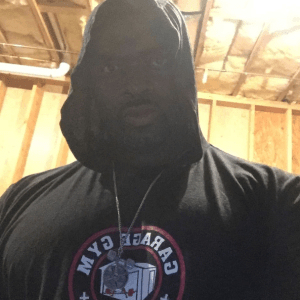
I managed my body fat through diet to keep my weight controlled. I wanted to gain muscle where I could while not over eating realizing I have no method to work off the extra calories that I was really up for doing. Although during this time I did not have abs I also did not have multiple stomachs. I believed that if I kept my body in an anabolic state once I was able to train the benefits would translate into a faster recovery which I believe it did. That is what I put my energy and research into and did not take the heavy drugs the doctors was trying to prescribe. My pain was very manageable and the sooner I started lifting the better I felt. I have learned that once you have sustained any type of major injury the sooner you can get back to some normality the better. Once you start lifting again reset those goals with some extensions and work your way back. A dream deferred is not a dream denied.
When’s your next competition, I saw you say something about next year, what show are you shooting for?
I have not identified a show yet as I need to do some rebuilding of right leg but having completed the core of my rehab and being released to train I would look to be somewhere near the fall of next year hopefully before stepping on the stage again after such a long layoff.
I heard that! How can people get in touch with you to ask advice or to set up a training session. And how can they follow your training to watch you eat steel and chase that dream?
To follow me just catch me on Instagram @allenbobbyjr or on Facebook @BobbyAllen. I save most training related items for Instagram and share a more balanced family life with Facebook.
Thanks for sharing your story with us Bobby!
The post Bobby Allen: Husband, Father, Bodybuilder appeared first on Garage Gym Life.
John Greaves III's Blog
- John Greaves III's profile
- 1 follower


